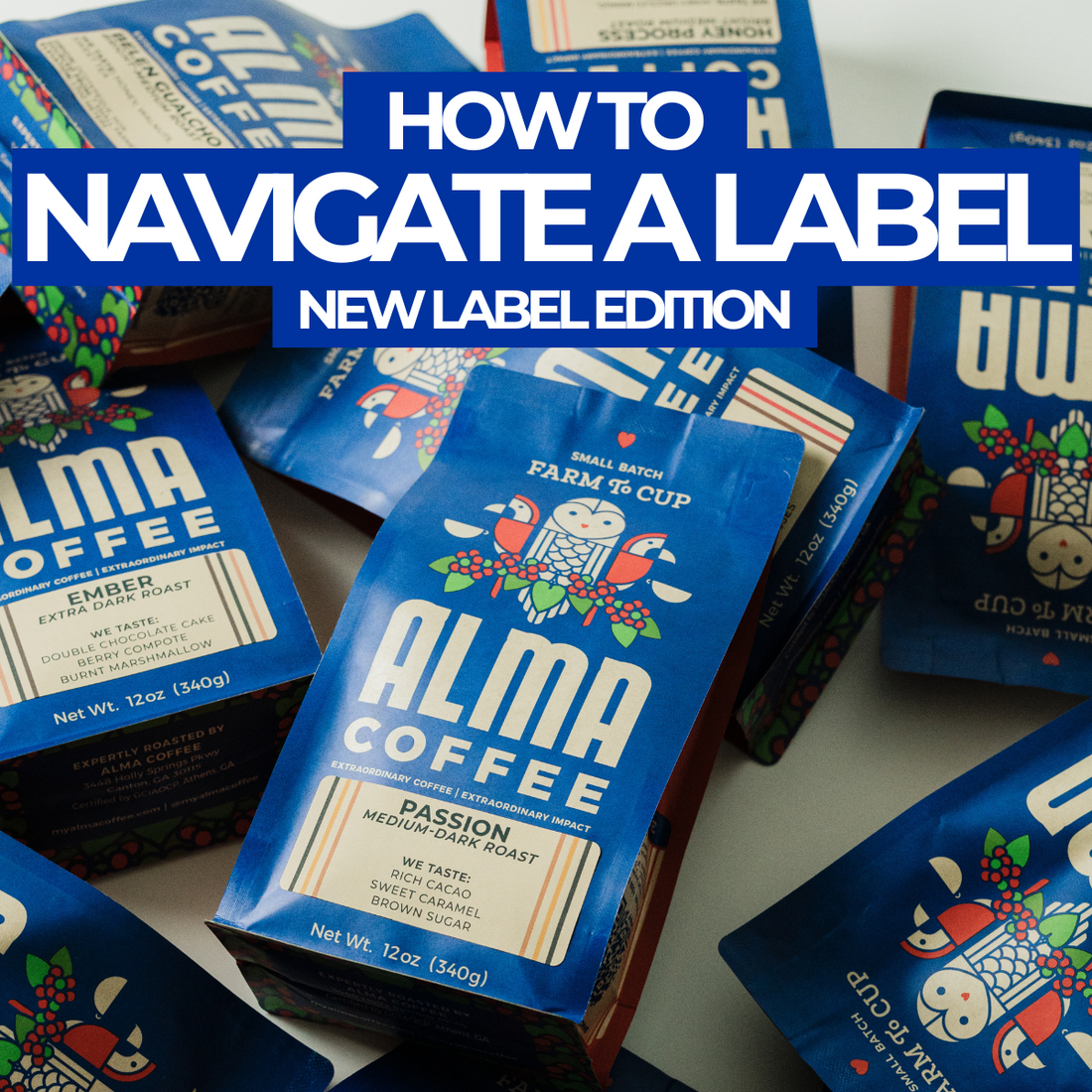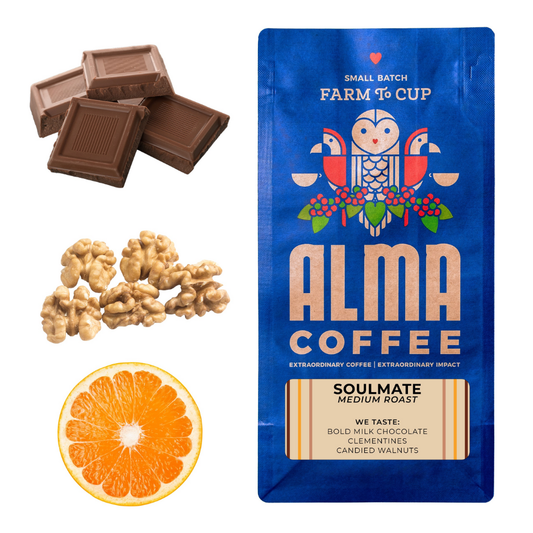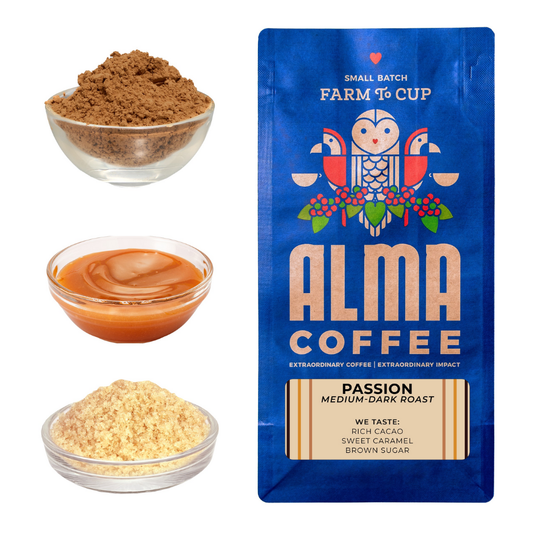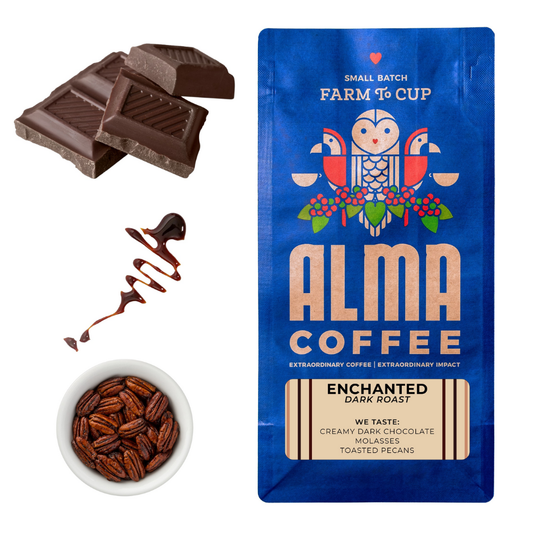
How to Navigate a Coffee Label
Share
Coffee labels are designed to inform you about everything that affects final coffee flavor, but how exactly do they do that?
Whether you are new here or a veteran Alma Coffee drinker, you’re probably reading this today because you want to learn the ins and outs of navigating information found on a standard coffee label… and we don’t blame you!
We recently spent a lot of time revamping the design of our own in-house coffee labels to be as informative as they are aesthetic; however, even taking this approach, we are still getting just as many questions about information found on the new label designs as we did with the old.
For starters, it’s important to note that coffee labels are intentionally designed to give you as much information as possible about not just a coffee’s flavor, but also the origin, process, and roasting techniques that directly affect those flavors after brewing.

As much as we like to have fun and keep coffee casual, we also have a first-hand understanding of just how complicated it can be to produce your favorite beans from farm to cup, and translating this vast amount of important information in a 3.5” label has truly put our graphic design team to the test...
That’s why, as we update the design of each of our bag labels, we focus on emphasizing the variables that directly affect the flavors you’ll likely experience in that final cup—if you’re here wondering what each of those variables are and what they mean, get ready for a full breakdown!
In this week’s Alma-nac blog, we’ll be walking through what each piece of information on our coffee labels actually is, how it individually affects the flavor of your final cup, and then breaking down the process behind our design that helps translate this information to those that may not be reading this blog post!
The Big Three: Roast Name, Roast Profile, and Coffee Processing
Ready to learn everything there is to know about navigating a coffee label? Let’s begin by looking at the three most important pieces of information found on all coffee labels, using the Soulmate coffee label below as a guiding example.
HOW TO READ & UNDERSTAND THIS GUIDE:
You'll notice numeric red dot labels beside different pieces of information on the label below. you can reference the corresponding numbered subsections below the example label to learn more about something specific, or read through the entire blog in order for a full breakdown on navigating a coffee label in order of high to low importance.
The "Classics" Label

#1: Coffee/Roast Name
The largest and most important text on our label is the name of the roast itself. For coffees sourced from the Alma Family Farms, we’ve opted for non-traditional romantic themed names like Soulmate, Passion, and Enchanted.
If the coffee comes from an Alma-doption partner specifically in Honduras, such as Belen Gualcho, then the roast name will reflect the town, region, or farmer that grew that coffee.
If the coffee is "other origin" then the name will reflect the country that coffee is from. For example, this would be either our Colombia or Congo roast.
Additionally, a few of Alma's other roast offerings like Natural Process or Honey Process get their name from the coffee processing method used between harvest and export (more on that in section #3), which you can learn all about in our full-length blog on coffee processing.
#2: Roast Profile
You’ll always find our roast level as set by our master roaster underneath the coffee’s roast name, which is probably the most sought-after characteristic of any roasted coffee.
From extra bright to extra dark, the final profile of a roast directly affects the natural flavor notes you experience regardless of brewing method or origin, which you can experience for yourself by trying Honey Process and Enchanted (both sourced from the exact same farm) side by side.
#3: Coffee Tasting Notes
We have so much fun with the tasting notes here at Alma, as they are meticulously selected to help interested coffee drinkers understand the three most prominent natural flavors associated with a particular roast.
That being said, out of every inquiry we’ve ever receive related to our bag label design, the most frequent question/misunderstanding has to do with tasting notes, so let’s clear something up right off the bat: NO, tasting notes are not literal, objective, or consequential to any food allergies you might have.
In the coffee world, tasting notes are selected after many, many R&D sessions prior to the release of a new coffee roast or fresh harvest, and they are purely subjective interpretations a master roaster or Q Grader notes during the cupping process.
Following the guidance of the SCA Coffee Flavor Wheel (which we’ve also covered in a full-length blog), our master roaster evaluates a coffee’s sensory experience and highlights flavors specific to the bean, which can vary from broad sensory details (fruity, sweet, spicy, fire-roasted, etc.) to extremely specific notes (apple, molasses, nutmeg, smoky, etc.)
Of course, sensory experiences vary from person to person, so we typically consult multiple pallets before deciding on final notes that, in turn, are selected to give coffee drinkers a general understanding of what they might taste in their own morning cup experience.
ALMA'S TASTING COLOR CODE, EXPLAINED:
To help visually illustrate this concept on our bag labels, we added a “tasting color code” accenting the sides of the label, which uses the SCA Coffee Flavor Wheel to determine the color code.
In the Soulmate label above, for instance, the tasting color code uses pink for rosewater, maroon for red grape, and dark grey for black tea, each of which are literal representations of that tasting note’s color pallet.
Honduras-Specific Label

The Other Stuff: Origin Info, Source, and Elevation
Now that you have a better understanding of where to identify & understand our naming conventions, roast profile, and tasting notes, it’s time to cover a few other pieces of important information you’ll find on our bag labels.
The following pieces of label information—despite their font size—are just as important as “the big three” to final cup flavor, and can vary drastically depending on the origin or limited availability of a specific roast. These other descriptors are only featured on our Honduras-specific and other origin roast labels.
Other Origin Label

#4: Additional Information—Origin, Source, and Elevation
Underneath the tasting notes, you’ll find any and all information related to that coffee’s origin, including the name of the farm it was harvested from, the country/region it comes from, and the specific altitude at which it was grown.
Regardless of roast profile or processing method, each of these pieces of information play enormous roles in the natural flavors associated with that coffee—especially altitude and region.
Are you ready for a Coffee Label Pop Quiz...?
Just kidding! We don’t expect you to memorize all of the information we’ve outlined above, but we do hope this blog helped answer any and all questions you might have about our bag label design and process (if you’re interested in more design-focused breakdowns, be sure to read our blog on the evolution of Alma’s bag design too)!
Of course, if we missed anything above, be sure to let us know in the comments below what questions you still have and we’ll be sure to answer them! It is our hope that these little tips and tricks help to guide you as you navigate our coffee offerings.
If you liked this blog post and found it informative or enjoyable to read, be sure to subscribe to our email newsletter below to get notified when the latest blog posts publish! We dedicate our Alma-nac Blogs to a wide variety of topics ranging from FAQ’s, coffee history, coffee science, direct trade partnerships, and much, much more!
Written by: Kelley Bostian
Edited by: Lizzy Smith





